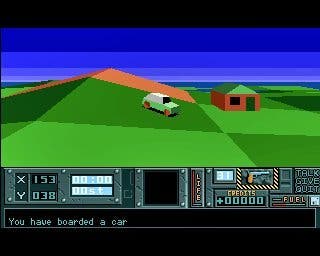Born Free: the History of the Openworld Game
From Adventure to Urban Chaos.
The final notable entry in this compact flurry of free-roaming innovation is, to my mind, the game that most obviously inspired the openworld games we take for granted today. And yet, few people seem to remember it, while fewer still ever played it. Hunter was the name, a 1991 Amiga and ST release by Activision. Much like Midwinter, you were cast as the lone soldier capable of taking down an enemy army, but even through the blocky graphics and rudimentary character models, it's hard not to see the resemblance to the later GTA games. While it wasn't exactly overstocked with buildings, those that did exist could be entered, and interaction with the NPCs inside was vital to success. The game even offered three ways to play; the narrative-driven Hunter mode, the reassuring linearity of Missions mode and the completely open-ended Action mode, where you were free to destroy the enemy installations in whatever order you fancied, using any means available.
It's in its generous exploration options that Hunter's influence is still being felt. Over a decade before GTA allowed players to roam its urban sandbox in dozens of different ways, Hunter was offering a generous selection of vehicles. Set across a series of islands, players were able to explore the world on foot, or take advantage of the numerous transport options. From obvious selections, such as cars and boats, to less obvious ways of getting around, like bicycles and surfboards, Hunter offered one of the most versatile gaming environments of its time. There was even a helicopter, allowing aerial exploration for anyone capable of mastering its twitchy controls.

With the prospect of open-ended 3D worlds firmly established, it took the games industry a few years to really take advantage of it and hammer it into the shape we know today. Quarantine, the 1994 PC and 3DO openworld car game, is often cited as an example of the genre's development, though frankly it has more in common with purely vehicular romps like Carmageddon and Driver than anything else. No, we'd have to wait until 1997 for the potential to be realised, thanks to a certain bunch of Scottish rogues.
Grand Theft Auto burst onto the PlayStation and PC in 1997, bringing together the top-down lunacy of arcade games like APB with the open-plan cityscapes so tantalisingly suggested by the games we've already dissected. Its viewpoint helped to distance the gamer from the amoral carnage they were creating, but by applying a dark sense of humour to the sandbox arena, DMA Design found the way to make such epic exploration appeal to the masses.
And yet...we're not going to dwell too much on GTA just yet. While the original game, and its sequel, were clocking up the sales DMA had another stroke of genius going largely unnoticed on the N64. Body Harvest launched exclusively on Nintendo's console in 1998, and in retrospect provides a pretty much complete template for the game GTA III would become. Notably similar in style to Hunter, Body Harvest found players defending towns and villages from voracious aliens, completing basic missions along the way. Numerous vehicle types were available, with players free to jump in or out of them at any time. The game was still restricted by the traditional level and boss battle formula, but in terms of technical development, it was clear where the GTA series was going next.

But before we get there, lets quickly tip our hat respectfully in the direction of Urban Chaos, Mucky Foot's openworld cops-and-crims game which beat GTA III to the shelves by two years. Released for the PC in 1999, before slowly making its way to both Dreamcast and PlayStation, Urban Chaos (not to be confused with the recent riot-based first-person shooter) featured Darci Stern, a rare black female action lead in a game, cleaning up the streets of Union City. Able not only to run and drive, but also to clamber onto rooftops and engage in combo-based fist fights with suspects, Urban Chaos was a resounding flop on release, though its influence on later titles such as Crackdown are hard to ignore.
And so we reach 2001, and the end of our journey with the launch of Grand Theft Auto III. Although I've hopefully shown that its impact was hardly unprecedented, it remains a landmark game as much for its attitude and swagger as for the way it nimbly pulled together the disparate threads left dangling by many of its forebears. Once gamers had visited Liberty City, the prospect of freely exploring expansive worlds in a non-linear fashion went from being a curious backwater of the adventure genre and became the preferred choice for many third-person action games. And, just as we waited to see what GTA III could deliver, so we're now waiting to see what innovations GTA IV can add to the mix...and whether or not it will be enough to retain its crown as the daddy of openworld gaming.
